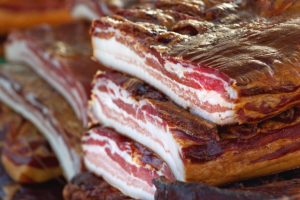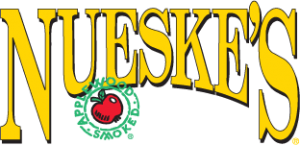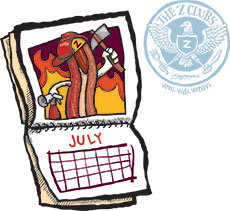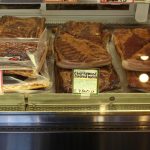
Bacon nirvana is within reach for bacon lovers. Zingerman’s Delicatessen knows all the best bacon makers and has curated a selection of the best bacon in the world. Not all bacon is created equal.
As Ari Weinzweig, Zingerman’s co-founder said in Zingerman’s Guide to Better Bacon “Like most traditional foods, there really isn’t all that much to mess with when it comes to bacon. Either you do it right, or you make the sort of stuff that accounts for 99 percent of what’s sold in supermarkets. That said, I guess it shouldn’t come as a shock to me that there are such huge quality differences between the bacon consumers can buy. While the word “bacon” appears boldly on all of them, there’s pretty drastic differences from one to the next. Mass-market bacon is almost always loaded up with salt, primarily, to mask the lack of flavor in otherwise almost tasteless meat. Lastly, bad bacon adds the lugubrious flavor of liquid smoke to the meat, trying to make up for lost time and lost woods because the pork isn’t ever put in a real smokehouse. Happily not all bacon is made for the mass market. There are great tasting, full-flavored traditional offerings out there.”
Read on for the stories behind these passionate pork people and all the ways we can expand your bacon horizons.
Bacon Lovers Know That Great Bacons Taste Better
Nueske’s Wisconsin Applewood-Smoked Bacon
 If you want a big time testimonial to get you to try Nueske’s, take it from the great, late, reporter of politics and food, R. W. Apple, who wrote in the New York Times that Nueske’s was “the beluga of bacon, the Rolls-Royce of rashers.” If you’re one of the few people in town here who hasn’t actually eaten it, Nueske’s bacon is meaty, subtly sweet (I think as much from the influence of the applewood as from the sugar in the cure), and so good that we’ve been cooking it every morning at the Deli for the last twenty-five years now.
If you want a big time testimonial to get you to try Nueske’s, take it from the great, late, reporter of politics and food, R. W. Apple, who wrote in the New York Times that Nueske’s was “the beluga of bacon, the Rolls-Royce of rashers.” If you’re one of the few people in town here who hasn’t actually eaten it, Nueske’s bacon is meaty, subtly sweet (I think as much from the influence of the applewood as from the sugar in the cure), and so good that we’ve been cooking it every morning at the Deli for the last twenty-five years now.
Tanya Nueske, granddaughter of the founder, is about as passionate about her product as you’re going to get. If the bacon wasn’t so darned good it’s not unlikely her bubbliness could be taken to be a bit over the top. But the bacon is so good that it comes across as the sincere love of her product that it is. “What we do is a very old tradition. My grandfather started up selling the bacon in 1933. He started out smoking over applewood. And he had a way of doing it and a style that came from his grandparents.” He has a good sense of style in a personal way too—If you’re out at Zingerman’s Roadhouse you can see him, dressed snappily in a newly-pressed Nueske’s delivery uniform, looking out at you from his photographic perch above the fireplace.
And even though she’s been around it her entire life, she still loves to eat it, and eat it often. “I eat bacon so much. I eat it plain all the time. We used to do some toasted buns with olives, sautéed onions, bacon and cheese and sour cream. You put ‘em under the broiler—it’s so good.” The passion for the products comes through. We also take our hot dogs and we split them down the middle and add cheddar cheese and a pickle and wrap the whole thing in bacon and run it under the broiler. Basically, we use bacon with everything!”
Not surprisingly, they start with higher quality hogs—primarily a cross of Yorkshire, Hampshire, Landrace and Berkshire. “One of the biggest differences we find is in how they’re fed,” Tanya told me. “We do a feed that’s more barley and corn mixture. We’ve been working with our suppliers for well over 25 years. And we still hand trim everything.” The Nueske’s cure the fresh slabs of bacon for at least 24 hours, hang them to dry for a day or so, and then smoke them for another. “It gets an awesome flavor because it’s been smoked so long,” she said.
“We design our smokehouses ourselves and have ‘em built for us,” she explained. “And,” she added, “we still use actual applewood logs. People should know that ‘applewood smoke’ can mean almost anything these days—apple juice, apple-smoke flavoring . . .But we only use real logs. The smoking is all hand controlled by the smokemaster. It’s a very artisanal thing.” She laughed and then added, “The smokehouses are like children. The smokemaster will tell you that each smokehouse is different.”
Without question, Nueske’s has proven one of the most popular foods we’ve got for sale anywhere in our organization. We sell lots of it for folks to take home to cook in their own kitchens and we also use it extensively here. If you come visit, you can try it on any number of sandwiches, in the greens at Zingerman’s Roadhouse or the Peppered Bacon Farm Bread from Zingerman’s Bakehouse. Its flavor is on the mellower side, with soft sweetness from the applewood that I think amplifies the natural sweetness in the high quality pork the family goes to such lengths to source.
Be sure to try the cherrywood smoked variety from Nueske, too!
Arkansas Peppered Bacon
One of my total long time favorites, this special pepper-coated bacon is cured and smoked at the foothills of Mt. Petit Jean in Arkansas. The family has been at it for over sixty years and they’re still using the recipe they started with back before WWII. It’s cured in a wet brine of salt, sugar and spices for four or five days (the exact nature of which is a family secret), smoked over hickory for just under 24 hours, then rolled in brown sugar and finally hand-rubbed with cracked black peppercorn.
There are so many things you can do with this bacon, I can’t even begin to list them all here. I love it because it’s less sweet, more spicy and very meaty, so much so that I sometimes don’t get as much bacon fat out of it as I want if I’m cooking the bacon as an ingredient rather than just to eat. It’s great on everything from burgers to egg dishes to just about anything else. One really great way to use it is in the braised bacon recipe from Molly Stevens award-winning book All About Braising. She learned the dish from Judy Rogers at Zuni Café. You can check out the details in Molly’s book. The recipe is far more involved than I’m going to be able to tell you here, but basically it calls for a nice slow-braise of a large chunk of bacon in broth and vegetables before using it to make pasta carbonara. The braising enriches the flavor of the bacon in a big way and I really like the way the pepper on the Arkansas bacon livens up the sauce.
Hungarian Double-Smoked Bacon
A staple in Hungarian cooking, the authentic article isn’t allowed to be imported into the US, but it’s been made eaten in the US for years by the long standing Hungarian immigrant community. The Hotel Butcher, Garde Manger and Carver, published in 1916, lists it amongst the country’s better bacons, but adds parenthetically that it’s “Not much relished except by foreigners.” As the name implies, the Hungarian bacon is intensely smoky. It’s great as a seasoning in stews and soups. Personally, I like it a lot in bean salads or fried then mixed into scrambled eggs. In Hungary, I’ve been told people used to hold pieces of it over the fire and catch the drippings on a piece of rye bread along with some onion and pieces of the now-crisply cooked bacon. It’s sort of like an inverted version of bacon fat fondue.
Alternatively, you can toss the drippings onto vegetables as a salad dressing. In either case , sprinkle on some good Hungarian paprika as well. It’s great for making traditional Hungarian potato salad—fry small pieces of the bacon until crisp, then remove them from the pan. In the bacon fat, cook some chopped sweet onion until soft. Add a little flour and stir until smooth, then add a bit of vinegar and sugar and cook for a few minutes until you have a smooth dressing. Pour the dressing over the just cooked potatoes and sprinkle on the bacon pieces, adding a good sprinkling of Hungarian paprika over top and eat it while it’s hot.
Virginia Bacon from Sam Edwards
 A pillar of the traditional pork world, Sam Edwards is still curing and smoking bacon (and great country ham and sausage as well) just as his grandfather and father did it in the town of Surry in Eastern Virginia. This is country-cured bacon the way it’s been done for many centuries. “We start with fresh pork belly that has the right lean-to-fat ratio,” he told me. “In 99% of bacon today, water is the first ingredient. But we dry cure. We literally rub it with salt and sugar. We leave the bacon in the salt and sugar for seven to ten days. Then we rub it off and smoke it for about 18 to 24 hours over green hickory to get the color and flavor we want.”
A pillar of the traditional pork world, Sam Edwards is still curing and smoking bacon (and great country ham and sausage as well) just as his grandfather and father did it in the town of Surry in Eastern Virginia. This is country-cured bacon the way it’s been done for many centuries. “We start with fresh pork belly that has the right lean-to-fat ratio,” he told me. “In 99% of bacon today, water is the first ingredient. But we dry cure. We literally rub it with salt and sugar. We leave the bacon in the salt and sugar for seven to ten days. Then we rub it off and smoke it for about 18 to 24 hours over green hickory to get the color and flavor we want.”
That flavor is very good—subtly sweet and very smoky at the same time, terrific for eating as-is on sandwiches or for flavoring bean dishes, soups or stews of all sorts. It’s bacon for bigger-flavored dishes—I like this one particularly crisply fried although Sam says he likes it softer. Because it’s got such a big flavor it’s great just served up simply for breakfast with (Anson Mills!) grits and eggs!
Broadbent’s Dry Cured Kentucky Bacon
Cured by Ronnie and Beth Drennan, formerly in the town of Cadiz (pronounced “Katy’s”) and now twenty-five miles down the road in Kuttawa, in the southwestern corner of the Bluegrass state. Two of the nicest folks I’ve met in the food business, they’re Kentuckians through and through and they make a darned good bacon. The Broadbent company and the recipe for their cure date back to 1909 when Anna and Smith Broadbent started selling ham, bacon and sausage from their family farm. Ronny and Beth bought the company from Smith Broadbent III back in 1999 and worked with them for a few years to transfer the family’s knowledge and recipes. This wasn’t one of those city-kids-fall-in love- with-the-country-and-move-to-Cadiz-to-cure bacon stories—both the Drennans are from the area.
Ronnie remembers his dad curing country ham and bacon on the farm back when he was growing up. For the bacon, they cure fresh bellies with salt, sugar and nitrite. “We hand rub each belly and then we stack ‘em on the shelves about 7 or 8 slabs high. We leave ‘em for one week, then we warsh all the salt off and hang ‘em up on the bacon hooks and we let ‘em sit overnight and a day to set, then let ‘em sit. Then we smoke ‘em for 3 or 4 days. A lot of it depends on the weather. Sometimes it’ll smoke quicker and sometimes a bit longer.” It’s been a big hit and attention-getter amongst many of the food writers and chefs I’ve given it to try.
“Our bacon tends to remind people so much of what their grandparents did. They’ve moved off the farm and they get to taste this now. So many people say they haven’t had bacon like this in years.” Broadbent’s bacon brings big, bold flavors that are great for putting in stews or into dishes where you want some big flavor. Or, of course, if you like country bacon (as I do) it’s very good with eggs and grits or in long-cooked Kentucky-style green beans.
Don’t miss their red wattle breed bacon, made exclusively for Zingerman’s!
Benton’s Bacon from Eastern Tennessee
I had the chance to go to Benton’s in person, finally making my way down there after years of wanting to. Straight off I asked Allan about the obvious: “What makes the stuff so great?“ He smiled and answered softly, “The secret is that there is no secret.”
In his graceful Appalachian accent, he added “This is just the way bacon was made years ago.” He would know. “I was born so far back in the hills of Virginia that you had to look straight up to see the sun. We were desperately poor even by Appalachian standards,” he went on smiling, “but I didn’t know that. Neither side of my family owned an automobile. Neither owned a tractor. They took a gooseneck hoe and they farmed the land like that.” He thought for a minute, and added, “They actually raised almost everything they ate.”
The production methods—true to what Allan learned growing up—are not dissimilar to what Sam Edwards and the Drennans are doing, but with his family’s western Virginia mountain twist. Freshly arriving bacon slabs get a really good rub down with brown sugar and salt. After a couple weeks of curing the slabs are rinsed and then left to cure for another two weeks or so. From there the bacon goes out back, literally, to the smoke box. It’s all of maybe 20 feet square—big enough to roll a couple racks into but that’s about it. Allan smokes almost all of them over hickory. The bacon gets about 48 hours in the smoker, “but it’s a bit different every time,” he explained. The whole process takes about five weeks from the time they start ‘til they’re done. Making bacon like this is still a craft, not a science.
“Heat has a lot to do with it. You need heat to open up the meat to let it take smoke. We try to keep it at about 85 to 110 (°F) in there,” he explained. Benton’s is not a bacon that will sit casually on the edge of your eating. It’s an intense confluence of smoke, salt and sweet all at once; none dominates, all are pronounced. It’s like umami all in one bacon bit. Maybe more than any other bacon on this list, I kind of think Benton’s brings its own flavor to whatever you use it in. It’s not a small flavor. If you’re into it, this one will become your BLT bacon of choice. Add cornmeal coated fried catfish filet or fried green tomatoes and you’ve got something really special. Fry it, chop it, toss fresh vegetables into the bacon fat and roast at high heat ‘til they’re
browned and tender, then sprinkle with the chopped bacon.
My favorite thing to do with it, though, is probably to serve it—and its fat, in all its smoky glory—over a bowl of hot mush made from Anson Mills cornmeal. While it probably sounds stupidly simple in the context of fancy five star restaurants, that simple dish—made with two incredibly good ingredients—is amazingly delicious. I think it’s the Southern equivalent of eating just-cooked Martelli spaghetti tossed in a great Tuscan olive oil topped with freshly grated Parmigiano-Reggiano and black pepper.
Nodine’s Applewood Smoked Bacon
When we visit these artisan bacon makers or invite them to Ann Arbor for Zingerman’s Annual Camp Bacon®, their passion always comes through loud and clear. Nodine’s Smokehouse, a family owned business in the foothills of New England Berkshires, is no exception. Just listen to their love for their craft–“Our pride and joy! If you’ve only ever eaten supermarket, big-name-brand bacon your whole life, we urge you to try Nodine’s Smokehouse Bacon. This is real bacon, made by hand, in small batches. This is the bacon of our grandparents.”
From humble beginnings as a small, custom smokehouse in 1969, they’ve become a leading American manufacturer of meats and cheeses in Torrington, CT. After years of perfecting their recipes and traditional methods, Nodine’s bacon is featured in both small town markets and high class Manhattan restaurants. It takes time to cure and age all-natural USDA certified pork bellies, and to smoke it with the perfect balance of hardwood. But that’s what brings the flavor, and we’re here for it.
La Quercia Pancetta
One of our crew calls pancetta “bacon’s older brother,” which I think is a great description. You can enjoy Pancetta Americana as is, sliced thin, as part of a salami tray. Or buy a chunk and cut it coarsely and cook it with vegetables. Any way you’d use Italian pancetta you can use Pancetta Americana. If you’re adventurous, use it instead of American bacon too.
If you’re used to Italian-style pancetta—the unsmoked, rolled belly of a pig—La Quercia’s excellent Pancetta Americana has a few differences worth noting. First, it’s meatier. While there’s still a significant amount of pale white fat, as there should be (which glows gorgeously translucent when cooked), there’s more pork to sink your teeth into. Second, it’s cured, not fermented. That means there’s no skin, the texture is smoother, the flavor sweeter. In fact the aroma alone is worth the price of admission. Finally, in the case of whole pieces, La Quercia leaves their pancetta unrolled, so, whole, it looks like a large slab of American bacon.
Bring Home The Bacon
Head to the counter at Zingerman’s Deli where bacon abounds to find out what the latest selection is. Our knowledgeable staff would delight any bacon lover in helping you find the bacon that’s right for you. Once you’ve made your selections they’ll be sliced to order, by the pound or half pound. In fact you can get all the ingredients for your favorite Zingerman’s sandwiches by the pound!
We even offer grocery home delivery and free grocery curbside pickup. What could be better than your favorite bacon, fresh baked bread, corned beef and more, delivered straight to your sedan or directly to your duplex?
 Join The Bacon Club–The Ultimate Bacon Lovers Gift
Join The Bacon Club–The Ultimate Bacon Lovers Gift
If all this bacon talk is giving you cravings for the smoky stuff but you can’t get to Ann Arbor and Zingerman’s Deli anytime soon, we’ll come to you! Ship yourself the gift that keeps on sizzling, a monthly bacon club from Zingerman’s Mail Order. “The country’s finest slabs of hog” says Men’s Journal. Each shipment contains 12 to 16 ounces of artisan bacon, bacon stories, and bacon recipes. And your first delivery initiates you into the club with a free bacon primer booklet and a squeal worthy pig magnet. No wonder celebrity chef Bobby Flay called it a “Fantastic gift!”.
Written by Ari Weinzweig & Sara Hudson



